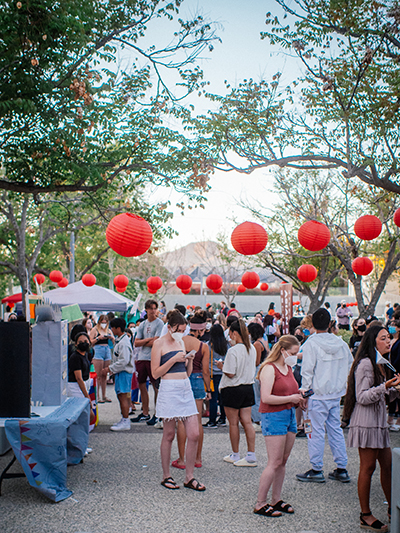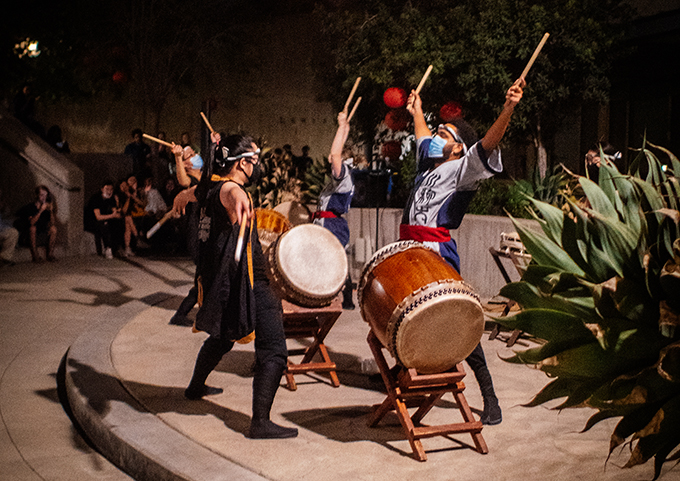Here is the honest truth: the Asian Student Association (ASA) cabinet and I did not anticipate the long line of University of Redlands students and community members forming at Gregory Hall to get into the ASA Night Market. No one did.
By 4:50 p.m. on March 26, a line of families and students curved and stretched halfway from Gregory Hall to the library; by 5 p.m., the line was even longer. At the sight, our club’s members beamed with excitement at the prospect of sharing our unique and respective cultures with the attendees.
Since January, the cabinet, club members, and I put everything into planning this event—especially our Recreation Chairs, Dylan Jin-seok Chae ’24 and Ryuko Novak-Murano ’23, who spearheaded the planning process. As the club’s president, I witnessed our team’s incredible dedication, which made the event’s success all the more exhilarating.
A sense of belonging

The ASA was founded in 2014 to create a safe community for the University’s Asian and Asian American students and their allies. In recent years, the club has hosted various events to bring awareness to aspects of Asian cultures. Prior to 2018, we celebrated Lunar New Year with Panda Express meals, but in recent years, the celebration grew into a formal event—as a result, attendance steadily grew in 2019 and 2020.
The club’s former president, Nikki Binondo ’20, planted the seed for the ASA Night Market. During one of our first meetings, she shared her goal: to actively try to represent all the different Asian cultures that exist on campus. She noted that Asia is not a monolith; it’s filled with unique cultures that can be represented by each of our members and the student body.
Unfortunately, the COVID-19 pandemic disrupted Nikki’s plans, but her successor, Wenmei Bai ’21, worked to continue her vision. When it was my turn to take the presidential mantle, I stressed my desire to continue that legacy when we were welcomed back to campus in 2021. As a Filipino American—a Southeast Asian woman—I wanted to represent my culture while empowering other Asian and Asian American students to represent their own unique cultures.
Sharing our cultures
In the summer of 2021, Dylan and Ryuko formulated an event that could achieve the club's goal. Vice President Harry Chen ’22 and I supported their vision that would become the ASA Night Market.
Dylan, who is Korean American, also introduced a theme: he wanted the event to encapsulate the South Korean pop-culture phenomenon known as “Newtro.” “It’s a combination of retro, traditional, and modern trends that young Korean [individuals] made. At a deeper level, we are tasked to choose one ethnicity over the other. [Newtro] was applied because we must individually navigate what it means to be American and our own respective ethnicity,” he said.

When the idea for the Night Market was introduced to the ASA members, it was met with passionate enthusiasm and positive reactions.
We also extended an invite to the reinstated Hawai’i Club to showcase their unique culture. Pacific Islanders are commonly grouped together with Asians and Asian Americans, but we wanted to emphasize that Pacific Islanders are separate and have their own community to clear up misconceptions of identity and address the different groups’ needs and beliefs. According to Hawai’i Club President Spencer Lopes ’22, the event “[gave] exposure to things that [the University and Redlands community] may not have had before, allowing them to learn things they may not have known.”
“It is a chance to educate and preserve our culture and heritage that has been forgotten and may be on the verge of extinction,” he said.
By the end of the planning process, ASA had 12 cultures represented at our Night Market: Cambodia, China, Hawai’i, India, Indonesia, Japan, Korea, Myanmar, Philippines, Taiwan, Thailand, and Vietnam.
A night of exploration
As twilight approached and the day grew cooler, music echoed throughout the Parrish Courtyard. Delighted chatter tangled with the music. The red lanterns strung from tree to tree danced with the gentle breeze. Something changed on the night of the ASA Night Market; although we were on University grounds, it felt like we were present at an actual night market in Asia: chaotic yet simple as everyone thrived off of each other’s spirited energy. Lines wove throughout the courtyard as people bonded over Asian and Pacific Islander food.
While keeping my eye on the Philippine booth, I joined Harry in ensuring the night proceeded smoothly. Wearing traditional Filipino garb (known to some as Maria Clara) I ran all over the courtyard: to the ticket booth, to Gregory Hall, and to each cultural booth. This allowed me to capture the activity of our club members, many of whom were stationed at their booths.
Just like me, most of them wore traditional clothing: our Japanese students—including our treasurer, Etsuka Tomonaga ’23, wore Yukata and Happi; our Vietnamese members donned the Ao Dai; Dylan wore Balinese clothes called Pakaian Adat Bali; other Filipino members also wore the Maria Clara; Sam Htet ’25 from Myanmar wore a Longyi; fundraising chair Alison Hale ’25 wore a Qipao to represent Taiwan; two of our Korean students wore their Hanboks; and our Cambodian members, including Secretary Vimean Rath ’23, wore a Sampot Hol.

With every visit I made, true elation was reflected in the eyes of the club members. They were glowing, something that Dylan and I later agreed was the highlight of the night. Watching them share their heritage and cultural staples with their classmates and the Redlands community—seeing the utter shock on their faces as they realized they were about to sell out of their food—was worth all the hard work we put into this event. When we transitioned into the performance segment of the event, the rows of Brown Amphitheater filled with participants, some opting to spread out along the steps closest to Appleton Hall.
While the ASA Night Market allowed attendees to experience the different Asian and Pacific Islander cultures, the event carried significant value for the ASA cabinet, members, and me. For us, the event allowed us to celebrate and appreciate our respective cultures while attending a predominantly white institution. It allowed us to feel empowered in our ethnic identity; it allowed us to feel seen.
In the event’s aftermath, I reflected on this: what transpired throughout the ASA Night Market is exactly what the club has always strived to do. Since its founding, we have endeavored to empower and educate Asian and Asian American students and our allies in ways that exhibit our unique and diverse cultures, accomplished through educational and engaging opportunities. This was why I joined ASA during my first year at the University—the club allowed me to be me: a young Filipino American woman.
Learn more about student life at the University of Redlands.






